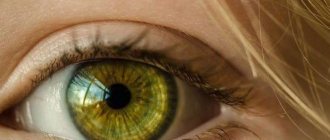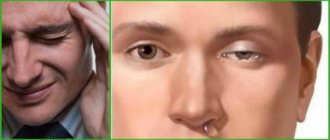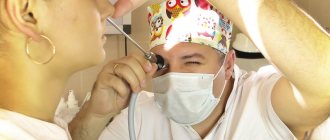Each of us has encountered such a phenomenon as twitching of the lower or upper eyelid; people call this condition “nervous tics” or tremor, but doctors call this phenomenon myokymia .
Myokymia (twitching) of the eyes and eyelids is an irritable condition in which a person experiences involuntary contractions of the orbicularis oculi muscle, which are repeated one after another. Eye twitching, various spasms of the eye muscles and eyelids are a very common phenomenon that tends to occur spontaneously. They appear suddenly, and just as suddenly they go away.
What it is?
Eye tic in neurology is when both eyelids contract or the muscles of both eyes contract strongly. This name is often confused with myokymia of the eyelid - involuntary contraction of the upper or lower eyelid (orbicularis oculi muscle). Both syndromes are hyperkinesis. That is, temporary or permanent contraction of fibers in the muscles. Myokymia is characterized by painlessness, lower amplitude, and frequency of twitching. It is rarely associated with the appearance of serious diseases and often accompanies overwork and stress.
From a few seconds to hours
The left or right eyelid may twitch for a few seconds, but sometimes this condition continues for several hours. It is impossible to stop a tic simply by willpower, but there are a number of exercises that will help cope with this unpleasant symptom. These exercises should be performed not at the time of an attack, but regularly, only in this case will they be effective. It should also be noted that gymnastics helps only those patients whose tics are associated with banal overexertion, fatigue and stress. If the reason why the eyelid of the right eye twitches lies in the disease, then complex therapy should be carried out.
How does this happen?
Due to vigorous activity near computers or phones, books, which requires the work of the facial muscles of the eyes, forehead and face as a whole, the eyes become very tired. This happens to such an extent that the neurotransmitters responsible for muscle function cease to be synthesized correctly. That is, chemicals do not transmit impulses from neurons to muscle tissue. The eyelid begins to twitch. Disruption of neurotransmitters is associated with stress and fatigue, and people often notice this. If the day turns out to be unpleasant, then the eye will definitely begin to twitch. Myokymia can be caused by some antipsychotics and nervous system stimulants in combination with difficult life events.
Causes of tic
There are various pathological reasons for the development of a tic, in which the eyelid of the right eye twitches. In addition to the usual lack of sleep, this may be a symptom of vitamin deficiency. To cope with these deviations, it is enough to lead a correct lifestyle, get plenty of rest and sleep, and eat only healthy foods rich in vitamins and microelements. To relax the muscular system of the eye, it is very important to consume a sufficient amount of magnesium ion, which is contained in the following products:
- Bananas;
- Peas;
- Rye bread;
- Dates;
- Beans and some others.
In addition, it is necessary to reduce factors that have a depressing effect on vision and the eyes:
- Hard work at the computer;
- Watching TV (especially in the dark);
- Reading books in low light conditions.
- If the problem has become chronic
In advanced cases, a tic in which the left and right eyes twitch, this symptom may be present almost constantly. In this case, it is very important to find out the true cause of what is happening, since such a symptom can occur against the background of a serious illness. To do this, you should contact a competent ophthalmologist, who will not only conduct a diagnosis, but also select an effective treatment.
When should you worry?
You should not worry if myokymia, a nervous tic of the eye, is not accompanied by other symptoms. Its very rare occurrence, or its occurrence for several days in a row, although no diseases are detected, can be considered the norm. Sometimes this can last for several years. In this case, the body requires unloading. You need to listen to him carefully and change your daily routine. Spend time outdoors, engage in quiet, relaxing activities, and take your mind off the daily hustle and bustle. But if myokymia appears along with poor health or fever, soreness, movements of other parts of the face, this may indicate a malfunction of the thyroid gland, lack of vitamins, multiple sclerosis and encephalitis. You need to be examined by a neurologist, ophthalmologist and psychologist.
causes and symptoms of eyelid twitching
Causes of nervous eye tics
The reasons why you have a nervous eye tic may be different, say neurologists at the Asfendiyarov Kazakh National Medical University. It is difficult to single out any specific one among them; most often it is a combination of factors that can provoke such a condition. Let's see what causes eyelid twitching.
Stress . Our bodies react differently when we are stressed, and eye twitching can be one of the signs and symptoms of stress. Especially when it is related to vision problems such as eye strain. By reducing the impact of factors that cause stress, it helps reduce the manifestations of myokymia and get rid of it.
Fatigue. Lack of sleep due to stress or other reasons can cause eyelid spasms. If you periodically experience this phenomenon, pay attention to your work and rest schedule.
Excessive visual stress is often the cause of eyelid twitching. With heavy visual load, especially in cases where you are forced to use glasses or contact lenses.
Possible reasons
Most often, a “nervous tic” of the eyelid causes:
- diseases of the nervous system that are inherited,
- lack of sleep - muscles do not have time to recover, which leads to their overstrain,
- overwork as a result of lack of sleep or hard work,
- stress (situations that require an immediate solution, leaving the comfort zone increases the level of adrenaline, and the muscles involuntarily contract,
- alcohol abuse, which can cause muscle spasms and interfere with the interaction of fibers and neurons,
- abuse of energy drinks, coffee, tea, chocolate - muscles quickly react to any irritants.
Simple moves
The first thing you can try when a tic appears is the following exercises:
- Starting position standing or sitting. You need to close your eyes very tightly, while the edges of the eyelids should be as close to each other as possible. After this you can open your eyes. About 5-6 such cycles need to be completed.
- In the same position, start blinking quickly, without stopping, for 10-20 seconds. This will also help stop eyelid twitching, as it relieves tension in the eye muscles, allowing them to fully relax.
It should be recalled once again that these exercises will only help those patients who have symptoms of fatigue and overexertion. If the causes of the disease are associated with pathological processes, then you need to try other more effective methods.
Prevention and treatment
Knowing the reasons, it will be easier to cope with a twitching eyelid and prevent the situation from worsening. Here are some simple options:
- give the body the right amount of time to rest and recover, organize sleep correctly,
- drink less caffeinated drinks, it is better to replace them with water,
- try not to create or enter into stressful situations, but treat everything calmly and judiciously,
- do gymnastics for the eyes,
- give your eyes a rest between activities,
- do not drink alcohol,
- properly organize the workplace, adjust the light and ventilate the room.
treatment of myokymia
In some cases, these simple steps will be enough to get rid of the problem. But if this does not bring any results, you need to consult a doctor. Together with him, undergo examinations of the nervous system, vision, and internal organs, after which he will select the appropriate treatment (medicines, lifestyle adjustments, lenses, glasses). You should contact a specialist in any case, as self-medication can worsen the situation.
Treatment
If the eye twitches, more serious treatment may be required. By contacting a neurologist, you will need to undergo an examination. After this, the doctor will assess the severity of the failure and prescribe medication. The regimen includes many different drugs. They are chosen depending on the type of disease that caused the eye twitching.
Most often, patients are prescribed to undergo a course of physiotherapy and massage. Comprehensive treatment will help restore the functioning of the nervous system. Folk recipes will be ineffective in case of serious failures.
Reasons for the development of nystagmus
Anomalies of intrauterine development, trauma during childbirth, disorders - including genetic ones - of visual acuity, transparency of the media of the eyeball, changes in the fundus, pathological processes in the optic nerve, retinal dystrophy, albinism can cause congenital nystagmus.
The causes of acquired nystagmus include:
- brain diseases (oncological formations, strokes, multiple sclerosis);
- malfunctions of the vestibular apparatus;
- poisoning, intoxication (medicinal, narcotic, alcohol);
- head injuries (with damage to the occipital region, optic nerves);
- refractive errors (myopia, farsightedness);
- strabismus;
- diseases with impaired media transparency (mature cataract, etc.).
Drug treatment and traditional medicine
Any drug therapy requires adherence to an optimal daily routine and adequate sleep. In this case, medications and procedures are designed to relieve the unpleasant symptom, as well as help the body recover and rest. For this purpose they prescribe:
Advertising:
- antipsychotics to relieve spasms;
- sedatives and tranquilizers;
- physiotherapeutic procedures.
Self-medication is unacceptable and often leads to negative consequences. Each drug and procedure must be agreed upon with the treating neurologist. As additional therapeutic techniques, folk recipes are used that do not have side effects, subject to individual tolerance:
- compresses made from honey, currant leaves and tea leaves;
- herbal decoctions based on mint, lemon balm, chamomile, blueberries;
- essential oils for aromatherapy or baths based on geranium, lavender, ylang-ylang, orange and cinnamon.
Regardless of the disease, prevention of pathologies is better than any treatment. Therefore, by following simple recommendations for self-relaxation, you can avoid twitching of the lower eyelid, as well as other health problems.
Symptoms of nystagmus
In addition to a general decrease in visual acuity, patients with pathological nystagmus complain of:
- the feeling that the world around you is moving;
- difficulty fixing the gaze on the object in question, a feeling of trembling, image displacement;
- the appearance of neutral zones. Neutral zones are head positions in which eye movements are not so intense. Often a person begins to hold his head in a certain position so as not to feel the “jumping” so much.
Symptoms worsen under stress and fatigue.
Types of nystagmus
Experts distinguish physiological and pathological types of nystagmus.
Physiological nystagmus
A variant of the norm, the body’s response to a change in head position or external stimuli. Eye movement during physiological nystagmus is caused by reflexes.
Physiological nystagmus is divided into vestibular (labyrinthine) and optokinetic. As the name implies, vestibular nystagmus of the pupils appears due to irritation of the human vestibular apparatus: exposure to the structures of the labyrinth with current, low or high temperatures, as well as during rotation of the body along the vertical axis. In addition, the labyrinthine type of nystagmus can occur if a person looks away to the side as far as possible: the eye muscles quickly tire, causing characteristic twitching.
Optokinetic nystagmus occurs when a person watches objects moving in one direction at a constant speed. With such observation, the gaze is directed most of the time in the direction of movement, but sometimes it “jumps” to the opposite direction.
Pathological nystagmus
Pathological nystagmus is a sign of the development of a particular disease. It can be congenital or acquired.
Congenital nystagmus appears soon after the baby is born. Acquired - during life due to exposure to various pathological factors on the body. Acquired nystagmus is usually divided into vestibular and neurogenic, depending on the lesions in which area it is caused.
If we talk about differences in the direction of movements, we can distinguish vertical, horizontal and rotatory types of pathological nystagmus. With vertical, the eyeballs move up and down, with horizontal - along the sides, with rotatory - in a circle and diagonally. The most common of these is horizontal nystagmus (up to 18% of the total number of cases). The rarest ones are oblique and circular.
Directions of eyeball movement during nystagmus
According to clinical manifestations, pathological nystagmus is divided into:
- jerky. Eye movements with this type resemble rhythmic jolts, and if the eye moves quickly in the direction of the jolt, then in the opposite direction it moves more slowly. Push-like nystagmus can be left- or right-sided, depending on which direction the push is directed.
- pendulum-shaped. The eyeballs move like a pendulum, as if swinging in one direction or the other.
- mixed. This type of nystagmus combines both jerking and pendulum movements.
- associated. Characterized by coordinated movement of the eyeballs.
- dissociated - when the eyes move uncoordinated, not matching in direction and amplitude.
In addition, nystagmus can be installational - when there are short, insignificant amplitude twitches of the apples when looking to the side (the reason for this is most often a failure in muscle coordination), and spontaneous, which is characterized by longer, more pronounced “jumps”.
Nystagmus in children
Nystagmus in children has its significant differences:
1. The likelihood of a child having the disease exists if the baby does not fix his gaze by the 4th week of life. This type of pathology is congenital in nature and is caused by the influence of unfavorable factors on the child’s brain during the prenatal period of development or a genetic disorder of the innervation of the extraocular muscles. This condition has the following characteristics:
- Appears by 2-3 months, persisting for life;
- Not visible during sleep;
- It has a jerky character and a horizontal orientation;
- There is a direction of gaze in which nystagmus does not appear.
2. Early acquired nystagmus is caused by pathology of both eyes, which reduces central vision. In terms of symptoms, it is similar to congenital, but appears a little later. In this case, the child notices eye twitching and this greatly bothers him. 3. Nodule spasm is a pathological condition that accompanies nystagmus, which develops by 3-18 months. It may be of unknown nature (and disappears by the age of 3 years), and is often caused by some pathology (including tumors) of the brain or cranial nerves. In this case, nystagmus has a small amplitude, high frequency and develops in the horizontal plane (sometimes with vertical components), accompanied by nodding of the head. 4. Hidden, latent nystagmus, develops due to infantile strabismus, occurs without paresis of upward or downward gaze. Such nystagmus is absent with open eyes, but appears when the intensity of illumination of one eye decreases and has a horizontal direction. 5. Infantile nystagmus is often observed with albinism, a genetic disease characterized by the absence of pigment in the iris. Involuntary eye movements in children can also be caused by post-traumatic encephalopathy or be the first signs of Meniere's disease.










